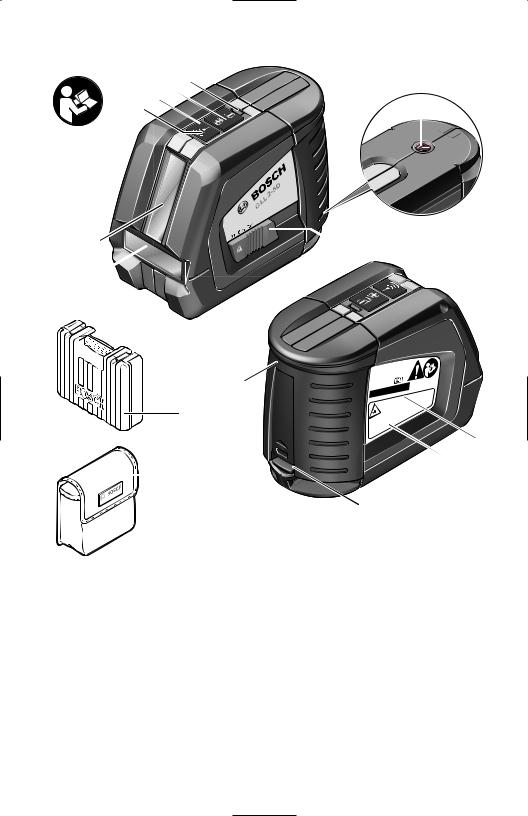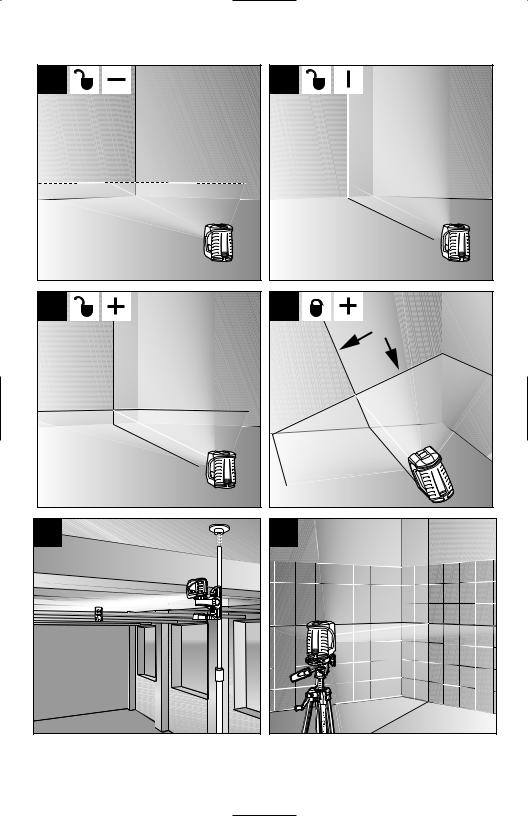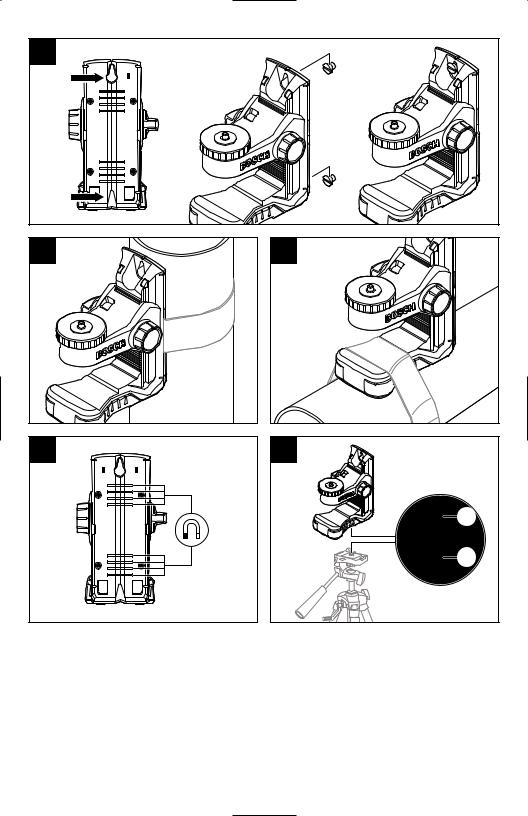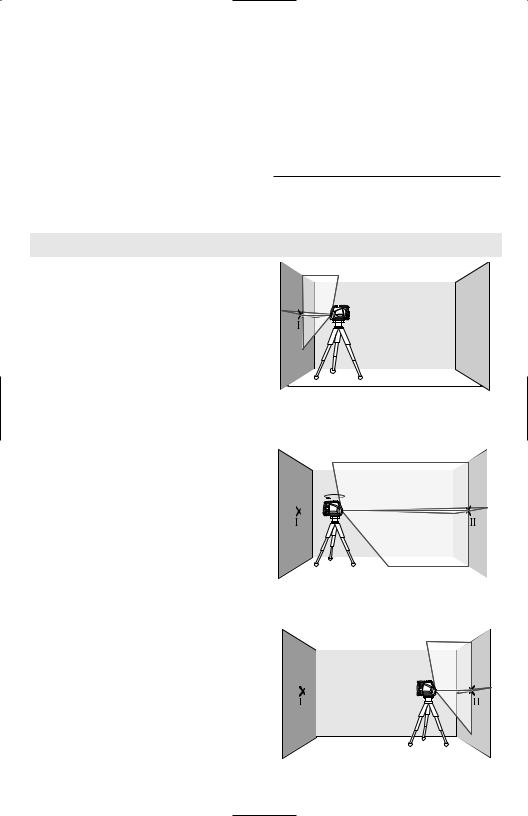Bosch GLL2-50 User Manual

IMPORTANT: |
IMPORTANT : |
IMPORTANTE: |
Read Before Using |
Lire avant usage |
Leer antes de usar |
Operating/Safety Instructions 
 Consignes de fonctionnement/sécurité
Consignes de fonctionnement/sécurité
Instrucciones de funcionamiento y seguridad
GLL2-50
|
|
|
|
Call Toll Free for |
Pour obtenir des informations |
Llame gratis para |
|
Consumer Information |
et les adresses de nos centres |
obtener información |
|
& Service Locations |
de service après-vente, |
para el consumidor y |
|
|
|
appelez ce numéro gratuit |
ubicaciones de servicio |
1-877-BOSCH99 (1-877-267-2499) www.boschtools.com
For English Version |
Version française |
Versión en español |
See page 6 |
Voir page 15 |
Ver la página 23 |
|
|
|


A |
B |
C |
D |
|
OR |
E |
F |
|
-3- |

G |
|
I |
|
6 |
cm |
|
|
K |
|
H |
14 |
18 |
2 607 990 031 |
0 601 015 B10 |
|
|
15 |
16 |
|
|
|
|
|
0 601 069 110 |
17 
0 601 015 A10
J
L
!WARNING Make sure that this device and the tool are securely mounted before operation.
!AVERTISSEMENT Assurez-vous que cet appareil et l’outil sont solidement assujettis avant de les utiliser.
Asegúrese de que este dispositivo y la herramienta estén montados de manera segura ! ADVERTENCIA antes de su utilización.
-4-

M
N
P
| 2
O
Q |
1/4" |
5/8" |
-5-

General Safety Rules
Read all instructions. Failure to follow all instructions listed below may result in hazardous radiation exposure, electric shock, fire and/or
serious injury. The term “tool” in all of the warnings listed below refers to your mains-operated (corded) tool or battery-operated (cordless) tool.
The following labels are on your laser tool for your convenience and ! WARNING safety. They indicate where the laser light is emitted by the tool.
ALWAYS BE AWARE of their location when using the tool.
2
IEC 60825-1:2007-03
<1 mW, 635 nm
Laser Radiation. Do not stare into the beam. Class 2 Laser product.
Radiación láser. No mire al rayo. Producto láser de Clase 2.
Rayonnement laser. Ne regardez pas directement dans le faisceau. Produit laser de Classe 2.
Do not direct the laser beam at persons or animals and do not stare into the laser beam yourself. This tool produces laser class 2 laser radiation and complies with 21 CFR 1040.10 and 1040.11 except for deviations pursuant to Laser Notice No. 50, dated June 24, 2007. This can lead to persons
being blinded.
DO NOT remove or deface any warning or caution labels. Removing labels increases the risk of exposure to laser radiation.
Use of controls or adjustments or performance of procedures other than those specified in this manual, may result in hazardous radiation exposure.
ALWAYS make sure that any bystanders in the vicinity of use are made aware of the dangers of looking directly into the laser tool.
DO NOT place the laser tool in a position that may cause anyone to stare into the laser beam intentionally or unintentionally. Serious eye injury could result.
ALWAYS position the laser tool securely. Damage to the laser tool and/or serious injury to the user could result if the laser tool fails.
ALWAYS use only the accessories that are recommended by the manufacturer of your laser tool. Use of accessories that have been designed for use with other laser tools could result in serious injury.
DO NOT use this laser tool for any purpose other than those outlined in this manual. This could result in serious injury.
DO NOT leave the laser tool “ON” unattended in any operating mode.
DO NOT disassemble the laser tool. There are no user serviceable parts inside. Do not modify the product in any way. Modifying the laser tool may result in hazardous laser
radiation exposure.
DO NOT use the laser viewing glasses as safety goggles. The laser viewing glasses are used for improved visualization of the laser beam, but they do not protect against laser radiation.
DO NOT use the laser viewing glasses as sun glasses or in traffic. The laser viewing glasses do not afford complete UV protection and reduce color perception.
DO NOT use any optical tools such as, but not limited to, telescopes or transits to view the laser beam. Serious eye injury could result.
DO NOT stare directly at the laser beam or project the laser beam directly into the eyes of others. Serious eye injury could result.
SAVE THESE INSTRUCTIONS
-6-

Work area safety
Keep work area clean and well lit.
Cluttered or dark areas invite accidents.
DO NOT operate the laser tool around children or allow children to operate the laser tool. Serious eye injury could result.
Electrical safety
Batteries can explode or leak, cause injury or fire.
To reduce this risk, always follow all instructions and warnings on the battery label and package.
DO NOT short any battery terminals. DO NOT charge alkaline batteries.
DO NOT mix old and new batteries. Replace all of them at the same time with new batteries of the same brand and type.
DO NOT mix battery chemistries. Dispose of or recycle batteries per local code.
DO NOT dispose of batteries in fire. Keep batteries out of reach of children. Remove batteries if the device will not be used for several months.
Personal safety
Stay alert, watch what you are doing and use common sense when operating a tool. Do not use a tool while you are tired or under the influence of drugs, alcohol or medication. A moment of inattention while operating a tool may result in serious personal injury or incorrect
measurement results.
Use safety equipment. Always wear eye protection. Safety equipment such as dust mask, non-skid safety shoes, hard hat, or hearing protection used for appropriate conditions will reduce personal injuries.
Positioning Device
Keep the Positioning Device 17 away from cardiac pacemakers. The magnets
(figure P) generate a field that can impair the function of cardiac pacemakers.
•Keep the Positioning Device 17 away from magnetic data medium and magnetically-sensitive equipment. The effect of the magnets (figure P) can lead to irreversible data loss.
Use and care
Use the correct tool for your application.
The correct tool will do the job better and safer.
Do not use the tool if the switch does not turn it on and off. Any tool that cannot be controlled with the switch is dangerous and must be repaired.
Store idle tool out of the reach of children and do not allow persons unfamiliar with the tool or these instructions to operate the tool. Tools are dangerous in the hands of untrained users.
Maintain tools. Check for misalignment or binding of moving parts, breakage of parts and any other condition that may affect the operation. If damaged, tool repaired before use. Many accidents are caused by poorly maintained tools.
Use the tool, accessories, etc., in accordance with these instructions and in the manner intended for the particular type of tool, taking into account the working conditions and the work to be performed. Use of the tool for operations different from those intended could result in a hazardous situation.
Service
Have your tool serviced by a qualified repair person using only identical replacement parts. This will ensure that the safety of the tool is maintained.
Develop a periodic maintenance schedule for tool. When cleaning a tool be careful not to disassemble any portion of the tool since internal wires may be misplaced or pinched or may be improperly mounted.
Certain cleaning agents such as gasoline, carbon tetrachloride, ammonia, etc. may damage plastic parts.
SAVE THESE INSTRUCTIONS.
-7-

Intended Use
The tool is intended for determining and checking horizontal and vertical lines.
Preparation
Inserting/Replacing the Battery
Use only alkaline batteries.
To open the battery lid 8, press the latch of the battery lid 11 in the direction of the arrow and remove the battery lid. Insert the supplied batteries.
When inserting, pay attention to the correct polarity according to the representation on the inside of the battery compartment.
When the battery indication 5 flashes red, the batteries must be replaced.
Always replace all batteries at the same time. Only use batteries from one brand and with the identical capacity.
•Remove the batteries from the tool when not using it for extended periods. When storing for extended
periods, the batteries can corrode and discharge themselves.
Features
The numbering of the product features shown refers to the illustration of the tool on the graphic page.
1Exit opening for laser beam
2Pulse-function indicator
3Pulse-function button
4Operating mode button
5Battery indication
6Tripod mount 1/4"
7On/Off switch
8Battery lid
9Serial number
10Laser warning label
11Latch of battery lid
12Belt Pouch*
13Case*
14Laser viewing glasses*
15Measurement plate with stand*
16Laser Receiver*
17Positioning Device
18 Telescoping Pole System
*The accessories illustrated or described are not included as standard delivery.
Technical Data
Working range
– Standard . . . . . . . . . . . . . . . . . .65 ft (20m)
– With laser receiver . . . . . |
. . . .165 ft (50m) |
Levelling Accuracy: |
|
Minimum |
|
Factory Accuracy . . . . . . . . |
. . . .(±0.3mm/m) |
. . . . . . . . . . . . . . . . |
. . . . .± .0036in/ft |
Typical Accuracy . . . . . . . |
up to 1/4 at 100ft |
Self-levelling range, |
|
typically . . . . . . . . . . . . . . . |
. . . . . . . . . . ±4° |
Levelling duration, |
|
typically . . . . . . . . . . . . . . . |
. . . . . . . . . .<4s |
Operating temperature . . . |
. . . .14° F 122° F |
. . . . . . . . . . . . . . . . . |
.(–10° C+50° C) |
Storage temperature . . . . . |
. . . .-4° F 158° F |
Relative.a.ir. .h.u.midity,. . . . . . . . . . . |
.(–20°C +70° C) |
|
max. . . . . . . . . . . . . . . . . . . . . . . . . . .90 %
Laser class . . . . . . . . . . . . . . . . . . . . . . 2 Laser type . . . . . . . . . . . . . . .635 nm, <1mW C6 . . . . . . . . . . . . . . . . . . . . . . . . . >3.33 Tripod mount . . . . . . . . . . . . . . . . . . .1/4-20 Batteries . . . . . . . . . . . . .3 x 1.5 V LR6 (AA) Operating lifetime, approx. . . . . . . . . . . .12 h Automatic switch-off after approx. . . .30 min Weight according to EPTA-Procedure
01/2003 . . . . . . . . . . . . . . . . 1lb (0.45kg)
Dimensions . . . . . . . .4-5/8” x 2-1/4” x 3-1/2”
. . . . . . . . . . . . . . . (118x 57 x 89mm) Degree of protection . . . . . . . . . . . . .IP 54 (dust and splash water protected)
Please observe the article number on the type plate of your tool. The trade names of the individual tools may vary.
The tool can be clearly identified with the serial number 9 on the type plate.
-8-

Operation
Initial Operation
•Protect the tool against moisture and direct sun irradiation.
•Do not subject the tool to extreme temperatures or variations in temperature.
As an example, do not leave it in vehicles for longer periods. In case of large variations in temperature, allow the
tool to adjust to the ambient temperature before putting it into operation. In case of extreme temperatures or variations in temperature, the accuracy of the tool can be impaired.
•Avoid heavy impact or falling of the tool. After heavy exterior impact on the tool, an accuracy check should always be carried out before continuing to work (see “Leveling Accuracy”).
•Switch the tool off during transport.
When switching off, the leveling unit, which can be damaged in case of intense movement, is locked.
Switching On and Off
To switch on the tool, push the On/Off switch 7 to the “  on” position (when working without automatic leveling) or to the “
on” position (when working without automatic leveling) or to the “  on” position (when working with automatic leveling). Immediately after switching on, the tool sends laser beams out of the exit openings 1.
on” position (when working with automatic leveling). Immediately after switching on, the tool sends laser beams out of the exit openings 1.
•Do not point the laser beam at persons or animals and do not look into the laser beam yourself, not even from a large distance.
To switch off the tool, push the On/Off switch 7 to the “off” position. When switching off, the leveling unit is locked.
Deactivating the Automatic Shut-off The tool switches off automatically after an operating duration of 30 minutes. To deactivate the automatic switch-off, keep the operating mode button 4 pressed for 3 s while switching on the tool. When the automatic switch-off is deactivated, the laser lines briefly flash after 3 s.
•Do not leave the switched on measuring tool unattended and switch the
tool off after use. Other persons could be blinded by the laser beam.
To activate the automatic shut-off, switch the tool off and then on again (without the
operating mode button 4 pushed).
Operating Modes (see figures A–D)
The tool has three operating modes between which you can switch at any time:
–Horizontal operation “–”: Produces a horizontal laser line,
–Vertical operation “l”: Produces a vertical laser line,
–Cross-line operation “+”: Produces a horizontal and vertical laser line.
All three operating modes can be selected in the automatic leveling mode. In the locked mode, either the horizontal operation or the vertical operation mode can be selected.
After switching on, the tool is in cross-line operating mode. To change the operating mode, press the operating mode button 4.
Pulse Function
The LR2 laser receiver allows the GLL2-50 to be used in situations in which the lines cannot be seen. The pulse function is activated separately from the selection of the operating mode. The GLL2-50 does not work with other laser receivers.
In pulse function, the laser lines flash at very high frequency and thus become detectable for the laser receiver 16.
To switch on the pulse function, press button 3. When the pulse function is switched on, the pulse-function indicator 2 lights up green.
When the pulse function is switched on, the visibility of the laser lines is reduced for the human eye. Therefore, shut off the pulse function by pushing button 3 again when working without laser receiver. When the pulse function is switched off, the pulsefunction indicator 2 is deactivated.
Automatic Leveling
Working with Automatic Leveling (see figure C)
Position the tool on a level and firm support or attach it to a commercially available photographic tripod.
When working with automatic leveling, push the On/Off switch 7 to the “  on” position.
on” position.
After switching on, the leveling function automatically compensates irregularities within the self-leveling range of ±4°. The tool is levelled in as soon as the laser lines no longer flash.
-9-

If the automatic levelling function is not possible, e.g. because the surface on which the tool stands deviates by more than 4° from the horizontal plane, the laser beams flash. In this case, bring the tool to the level position and wait for the self-levelling to take place.
In case of ground vibrations or position changes during operation, the tool is automatically levelled in again. To avoid errors, check the position of the horizontal and vertical laser line with regard to the reference points upon re-levelling.
Lock Mode - Working without Automatic Levelling (see figure D)
For work without automatic levelling, push the On/Off switch 7 to the “  on” position. When the automatic levelling is switched off, the laser line flash continuously.
on” position. When the automatic levelling is switched off, the laser line flash continuously.
When the automatic levelling is switched off, the tool can be held by hand or placed on an inclined surface.
Working Advice
•Always use the center of the laser line for marking. The width of the laser line changes with the distance.
Leveling Accuracy
Influences on Accuracy
The ambient temperature has the greatest influence. Especially temperature differences occurring from the ground upward can divert the laser beam.
Because the largest difference in temperature layers is close to the ground, the tool should always be mounted on a tripod when measuring distances exceeding 65 ft. If possible, also set up the tool in the centre of the work area.
Apart from exterior influences, device specific influences (such as heavy impact or falling down) can lead to deviations. Therefore, check the accuracy of the tool each time before starting your work.
First, check both the height as well as the leveling accuracy of the horizontal laser line, then the leveling accuracy of the vertical laser line.
Should the tool exceed the maximum deviation during one of the tests, please have it repaired by a Bosch
after-sales service center.
Checking the Height Accuracy of the
Horizontal Line
For this check, a free measuring distance of approximately 26 feet on a firm surface between two walls A and B is required.
–Mount the tool onto a tripod or place it on a firm and level surface close to wall A. Switch on the tool. Select cross-line operation with automatic leveling.
A B
26 ft
–Direct the laser against the close wall A and allow the tool to level in. Mark the center of the point where the laser lines cross each other on the wall (point I).
A B 180˚
–Turn the tool by 180°, allow it to level in and mark the cross point of the laser lines on the opposite wall B (point II).
A B
-10-
